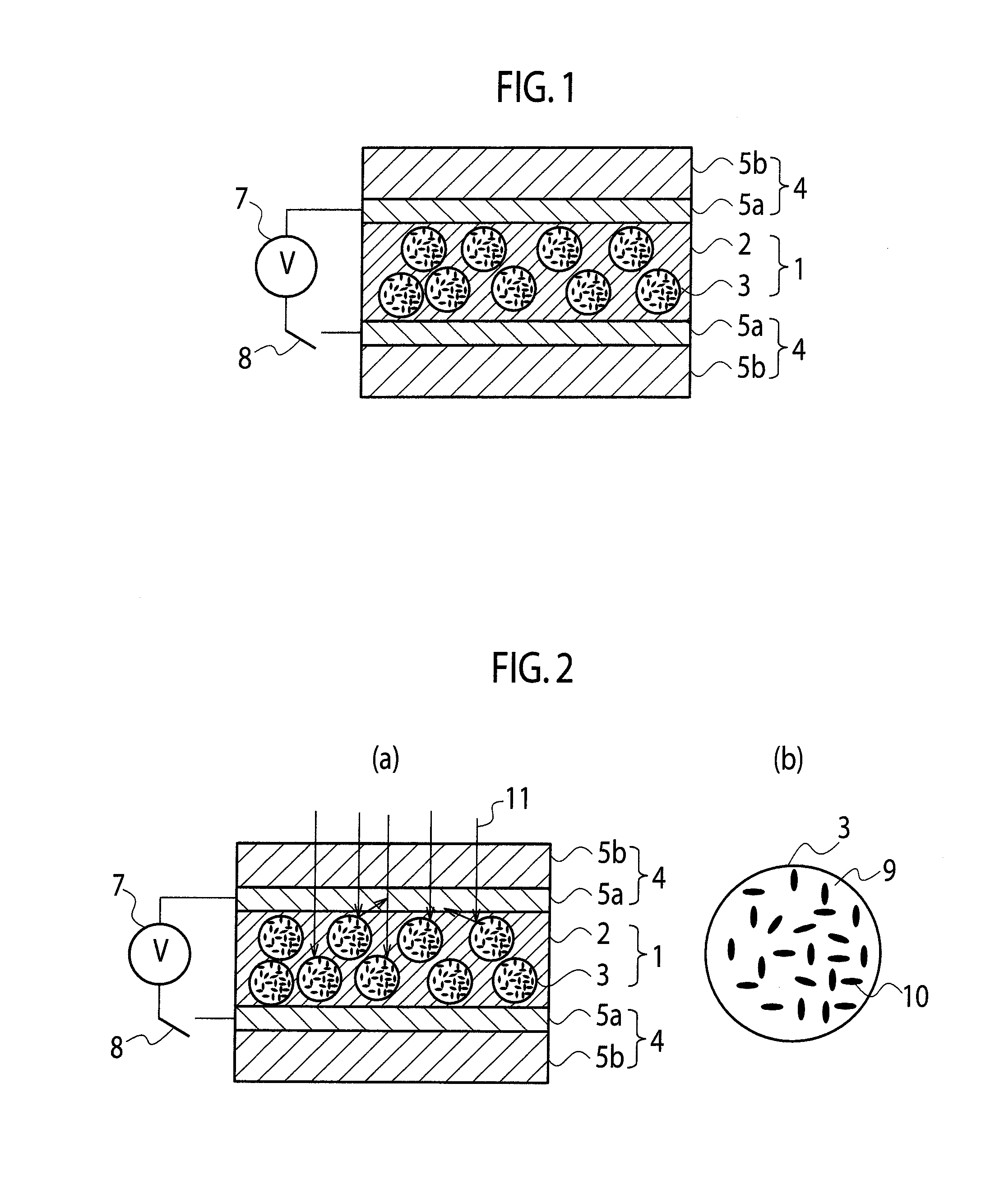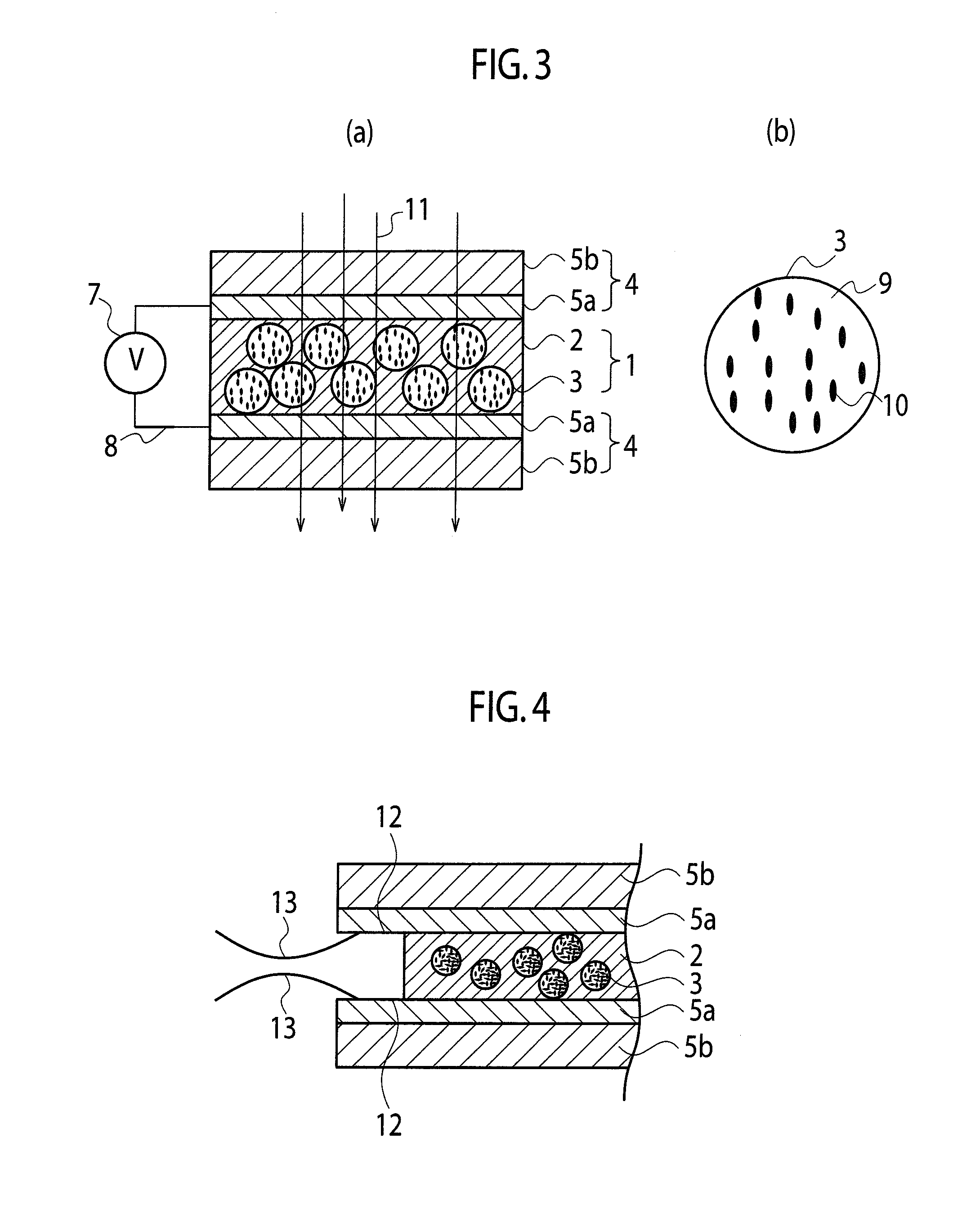Light control film
a technology of light control film and film film, applied in vehicle components, antiglare equipment, instruments, etc., can solve the problems of color phase change, change in optical density, and inability to control the light intensity, and achieve excellent radio wave transparency, small in-plane fluctuation of the surface resistivity of the transparent conductive layer, and stable driving
- Summary
- Abstract
- Description
- Claims
- Application Information
AI Technical Summary
Benefits of technology
Problems solved by technology
Method used
Image
Examples
example 1
[0209]2.5 g of the light control suspension obtained in the (Preparation Example for light control suspension) was added to 10 g of the energy-beam-curable silicone resin obtained in the (Production Example for energy-beam-curable silicone resin), 0.2 g of bis(2,4,6-trimethylbenzoyl)phenylphosphine oxide (manufactured by Ciba Specialty Chemicals Corp.) as a photopolymerization initiator, and 0.3 g of dibutyltin dilaurate as a coloration preventing agent. The mixture was mechanically mixed for one minute, and thus a light control material was produced.
[0210]Meanwhile, for the transparent conductive layer, an ITO powder (manufactured by Dowa Holdings Co., Ltd., average particle size: 30 nm) and a mixture of pentaerythritol triacrylate and pentaerythritol tetraacrylate (trade name: ARONIX M-305, manufactured by Toagosei Co., Ltd.) were mixed at proportions of 75% by mass and 25% by mass, respectively, and this mixture was dispersed in a solvent mixture of methyl ethyl ketone:cyclohexan...
example 2
[0225]A light control film was produced in the same manner as in Example 1, except that an ITO powder (manufactured by Dowa Holdings Co., Ltd., average particle size: 30 nm) and a mixture of pentaerythritol triacrylate and pentaerythritol tetraacrylate (trade name: ARONIX M-305, manufactured by Toagosei Co., Ltd.) were mixed at proportions of 80% by mass and 20% by mass, respectively, and the light control film was evaluated in the same manner as in Example 1. At this time, a photopolymerization initiator (1-hydroxycyclohexyl phenyl ketone) was added in an amount of 3% by mass based on ARONIX M-305. The thickness of the transparent conductive layer after curing was 1.0 μm.
[0226]The surface resistivity of the transparent conductive layer was 1800Ω / □.
[0227]The light transmittance of the transparent conductive resin substrate was 84%.
example 3
[0228]A light control film was produced in the same manner as in Example 1, except that an ITO powder (manufactured by Dowa Holdings Co., Ltd., average particle size: 30 nm) and a mixture of pentaerythritol triacrylate and pentaerythritol tetraacrylate (trade name: ARONIX M-305, manufactured by Toagosei Co. Ltd.) were mixed at proportions of 85% by mass and 15% by mass, respectively, and the light control film was evaluated in the same manner as in Example 1. At this time, a photopolymerization initiator (1-hydroxycyclohexyl phenyl ketone) was added in an amount of 3% by mass based on ARONIX M-305. The thickness of the transparent conductive layer after curing was 1.1 μm.
[0229]The surface resistivity of the transparent conductive layer was 1300Ω / □.
[0230]The light transmittance of the transparent conductive resin substrate was 85%.
PUM
| Property | Measurement | Unit |
|---|---|---|
| radio wave shielding property | aaaaa | aaaaa |
| frequency | aaaaa | aaaaa |
| optical density | aaaaa | aaaaa |
Abstract
Description
Claims
Application Information
 Login to View More
Login to View More - R&D
- Intellectual Property
- Life Sciences
- Materials
- Tech Scout
- Unparalleled Data Quality
- Higher Quality Content
- 60% Fewer Hallucinations
Browse by: Latest US Patents, China's latest patents, Technical Efficacy Thesaurus, Application Domain, Technology Topic, Popular Technical Reports.
© 2025 PatSnap. All rights reserved.Legal|Privacy policy|Modern Slavery Act Transparency Statement|Sitemap|About US| Contact US: help@patsnap.com



